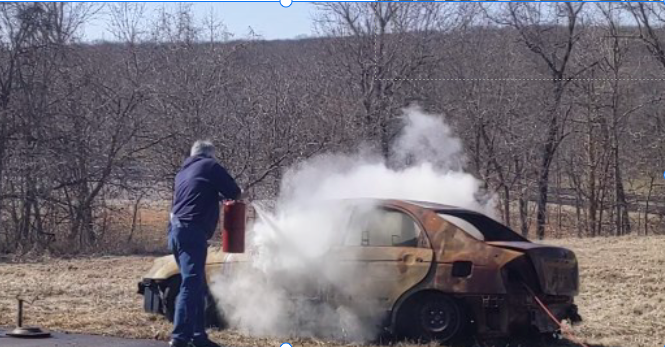
This article first appeared in the March 2022 Checkpoint Newsletter
We lucked out with the weather for the Crash-Fire-Rescue school at Ozarks International Raceway (OIR). While I would have preferred the 70 degree weather from a few days prior, the 50 degree weather was nothing to scoff at either. Several knowledgeable volunteers from across the Midwest Division shared their knowledge and experience with over 100 people interested in working flagging and communications at the new OIR.
GCR rule book
Chris Kern (KCR SCCA) and Mike West (National SCCA) welcomed everyone to CFR and gave a brief overview of the GCR rule book. These rules explain the why behind the processes we have in place. West reminded everyone that above all else, he wants us to have fun while helping at events. If you’re not having fun, please let one of the stewards know so that we can see if we can help.
The fire and medical crews from local volunteer departments moved to the garages to review specifically how the SCCA runs events as a sanctioning body since it does differ than some of the other sanctioning bodies that will also run events at OIR. When at an event, remember to thank them for their service as they are here to keep everyone safe—drivers and corner workers alike.
DOWNLOAD
EVs for EVs: The Basics of Electrified Vehicles for First Responders and Emergency Services [PDF]
Flagging
Chris Keith (KCR SCCA) discussed flagging. He has been flagging since 2002, and he has three rules—have fun, protect yourself, and protect your team. Flags are a way for corner workers to talk to the drivers and let them know what to prepare for on track. The role of flaggers on track is for the safety of everyone involves and to communicate that to the drivers. He reminded us that “our job is to give the race track back to the racers.”
Communication
Neava Ford (KCR SCCA) has worked several positions in flagging and communication, but currently handles race control. She noted that when she started, she had no clue what she was doing. So if you feel that way, that is completely okay. You will be paired with an experienced corner worker who will help you put the knowledge you learn here to use. Her tips related to clear radio communications—speak slowly and keep your traffic clear and concise. She also noted that a lot of what we do is subjective and situational. The more races you work, the more knowledge you will get and the better equipped you will be to evaluate each situation independently. Diane Struve (DMVR SCCA) joined Ford to discuss the operations team for communications. She noted to remember that the operations team is doing a lot of things simultaneously, so be patient as you wait for them to be ready for your radio traffic.
Signals and Corner Setup
Justin Walker (KCR SCCA) discussed hand signals and corner station set up. He also emphasized that your actions should always protect yourself first, then the car and driver. While radios are the best form of communication, we try to keep radios in the bunkers. When one person goes to check on the car, they must use hand signals to talk to the person with the radio in the bunker. He emphasized that the signals are pretty simple, not too creative, but even so remember to get familiar with them so that you know what to do should the need arise. A copy of the Flagging and Communication manual was passed out and is also available online with this link.
Walker also went over corner station set up:
- Check radio
- Check flags
- Have discussion with Corner Captain to see what the expectation is
- Check where the boundaries of your zone are
- Check fire extinguishers—check that it is charged and has a pin (tip it up and down to mix it up so it’s ready when needed)
- Check your surroundings
- Know your exits and keep those exits clear
Walker noted that corner workers where white or orange so you are visible but not confused as flag colors. Keep these colors in mind when bringing umbrellas, hats, rain jackets. Make sure to have a bag with the essentials—water, sun screen, bug spray, ear protection, paper and pens, rain gear, and anything else you may need weather depending. Dressing in layers is a good idea as mornings can start off cooler but heat up as the day goes on. Also bring a chair—you will not be sitting while the track is hot, but is nice to sit down between heats for a few minutes. He also emphasized having the flag at-the-ready but hidden from view of the driver (ie. tucked under your arm with one hand on the end corner and one hand on the stick so you are ready to pop it out at a second’s notice).
Assisting Fire and Medical Crews
After a lunch break, both fire and medical crews and the flagging and communication people were reunited to go over how corner workers can assist the fire and medical crews with extrication, putting out fires, and how to assist with medical concerns. We also drove around the track and checked out a corner station to visualize some of the things mentioned in the morning sessions.
Lots of people picked up the fire extinguisher to put out a small car fire. Several more people watched as local fire crews used specialized tools to tear apart a car.
As the day came to an end, there were a lot of good side discussions from both the drivers’ and the corner workers’ perspectives. They reminded everyone that the SCCA is a volunteer organization, but now that they are certified they can work for tracks.
The main theme throughout the school was that flagging and communication tries to keep incidents localized so that most of the track can be green and racers can continue to race as much as possible.


